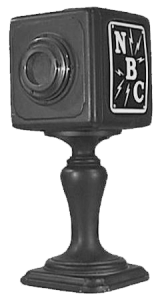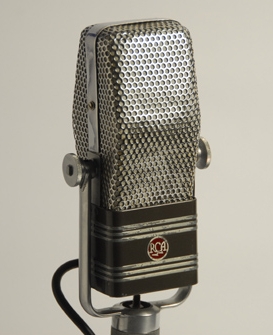
Microphones
No matter how you slice it, the broadcasting process starts with a microphone. This page is a rundown of some of the microphones that were used during the golden era. KWD has a few types in stock and plans to acquire more as station funding allows. While there is a "collecting" element to this, I want to put these mics to work in the studio.
I'm sure that some modern manufacturers can provide solid documentary evidence that the new WhizBang 1000 large diaphragm condenser has the best frequency response ever measured. And while I freely admit to a certain bias, I'm just as certain that the RCA 44 series mics did a better job of turning sound waves into electrical impulses than anything produced before or since. Besides, they look extremely cool.

RCA 44
This is the big one.The earliest model was actually designated the PB-31 and was introduced in 1931. Less than a year later, it was replaced by the 44A. Eventually, the 44B and 44BX rounded out the series. The 44-series mic was a breakthrough in microphphone technology. The carbon and condenser mics of the twenties tended to be noisy and very limited in frequency response. The new ribbon technology produced a frequency response that was virtually flat to 20 kilocycles, giving a crystal-clear signal that was a revelation at the time. Even now, these are treasured by many sound engineers and are still used in professional studios. |
|

RCA 74
The 74 series was introduced in 193x as a lower-priced (but still capable) alternative to the 44. It is quite a bit smaller than the 44 and is mounted on a ball joint, rather than the yoke used on the 44. The 74 uses the same ribbon technology as the 44, although the frequency response is not as good. Ribbon microphones are very susceptible to wind noise and could even be damaged by use outside a studio environment. It was often used as an announcer's mic or in the control room for talk back. In smaller stations, it was often employed as a substitute for its more robust big brother. |
|

RCA 77
This is placeholder text. This space is used to describe the microphone, its history, applications, and other information. |
|

RCA 88
This is placeholder text. This space is used to describe the microphone, its history, applications, and other information. |
|

Turner U9S
This is placeholder text. This space is used to describe the microphone, its history, applications, and other information. |
|

Western Electric 630A "8 ball"
The 630A was introduced in July 1935 at the NAB convention. It was intended for studio use in situations where its non-directional pickup pattern made sense. If you take a look at the film On the Air on the "Screening Room" page, you can see the famed (at the time) violinist David Runinoff using one. I've seen a lot of film clips and still photos that show these being used by the sound effects crew as well. |
|

Western Electric 639A
This is placeholder text. This space is used to describe the microphone, its history, applications, and other information. |
|
© 2009-2019 KWD Radio







